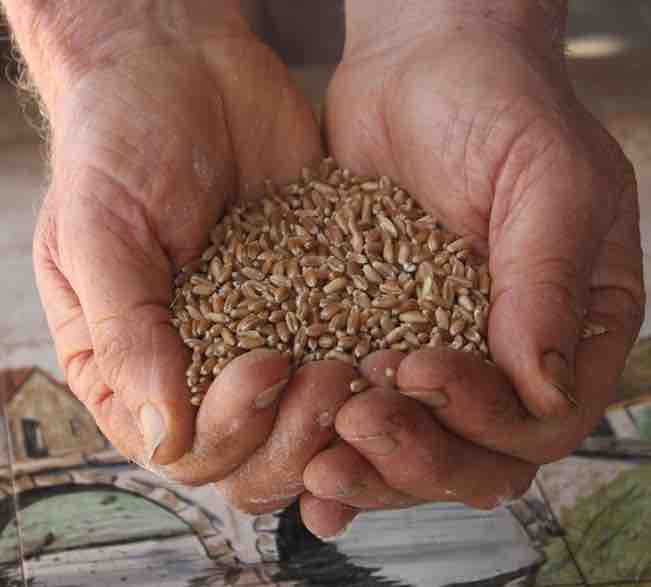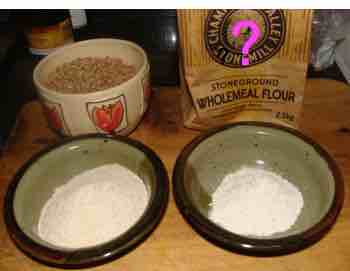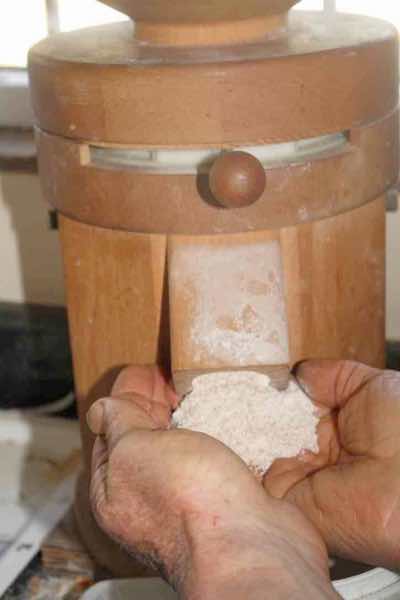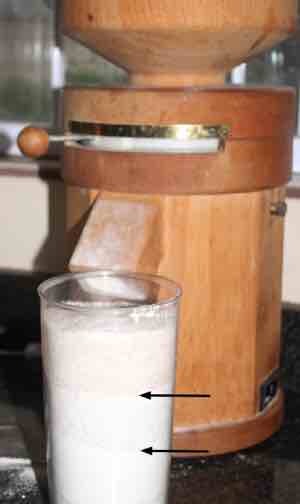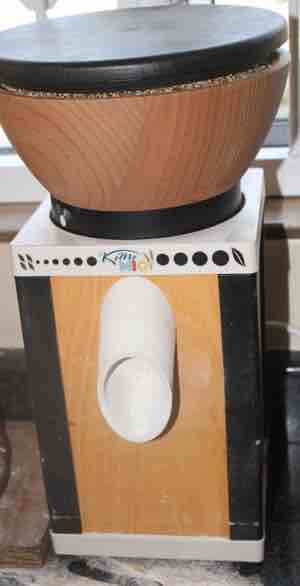| Back to Back Issues Page |
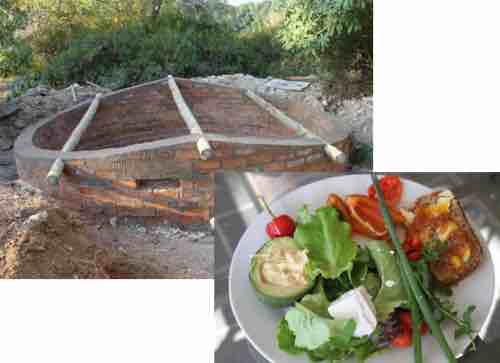 |
|
Mill your own flour August 06, 2021 |
DearMill your own flourGreetings from Bernard Preston to this our nineteenth newsletter about creating your own Cyan Zone; greater wellness for both your family and the planet. Our theme this month is how milling your own flour will mean a step-up not only in baking experience but also in personal health. The first thing that will strike you when seeing wheat being milled for the first time is the subtle aroma, something you probably have never smelled before, emanating from the flour. It has something of the aroma of fresh bread baking but also not quite the same; in short a rich, subtle and wonderful smell to greet the senses, as enduring and eternal as the taste of iced spring-water. Just as when you cut into the skin protecting an onion, certain aromatic phytochemicals are released into the air, so cracking the kernel of a grain of wheat gives you this rich mysterious smell. And just like an onion that has been lying around for days has lost its oomph,
so has your bread flour; there is absolutely none of this aroma associated with the refined stuff and even wholemeal that was milled weeks or months ago.
Of course this is not just about the aroma of freshly-ground wheat but also the loss of these important phytochemicals from commercial flour; they would improve not only the nutrition of your baking and also give it a much richer flavour. It is the step-up to a whole new baking experience. You will never appreciate it until you have your own mill. It's not just the aroma that wafts up from the wheat as it is being ground but a profound nutty, wheaty flavour in your baked goods as you switch from commercial to your own freshly milled flour; chalk and cheese.
Air in your flourFreshly-milled flour begins to deteriorate the moment oxygen gets to it; not appreciably in the first few hours, but it's happening.It's like a cat amongst the pigeons; first just a few feathers are flying about, the loss of the aroma, but then before long there's blood squirting and finally death of a bird or two.
Oils in wheatIt's highly complex, but the most important death is that of the important wheat-germ oil that starts to go rancid the moment it is exposed to air; it goes bad and you can smell it. Like nasty peanuts that get an awful taste and stink.There is in the flour a natural anti-oxidant called vitamin E that gives a measure of protection; for a period. Vitamin E is also a natural anti-coagulant in the blood; it helps prevent clots forming and, of interest, heart-attacks were almost unknown prior to the industrial milling of flour according to cardiologist, Dr Wilfred Shute. In short these oils are highly perishable; they go rancid so industrial millers remove them and the vitamin E with them. We tend to think only of fish, meat and milk when considering perishable foods; it happens just as surely with an apple or pumpkin once the skin has been penetrated, and with wheat, only more slowly.
Protein in wheatOne normally thinks of wheat as a starch, so perhaps it comes as a surprise that it is 13%-protein too, mostly gluten; more on that ticklish subject lower down.New research is emerging on the importance of protein, particularly in the older person to counter the loss of muscle, known as sarcopenia; it is the prelude to what is known as frailty-syndrome. That means unintentional weight loss, decreased energy levels and weakness particularly in the hands and legs, all long before their time.
“We found that higher protein intake was associated with a 30-percent lower risk of losing functional integrity with time; it clearly demonstrates the potential importance of a higher protein diet.” - Prof Paul Jacques Professor Jacques continues by stating that 'inflammaging' - the low grade chronic inflammation often associated with old age where everything aches - calls for increased protein, the problem being that many are pro-inflammatory. Their research found that elderly folk who ate the least amount of protein were twice as likely to have high inflammation scores as those who ate the most. However too much protein is hard on the kidneys, increasing the acidity in the body which is damaging to bone strength; that drop in pH is countered by the body by drawing calcium from our bones. That means osteopenia. Their recommendation is that we get more of our protein from non-animal sources like legumes, nuts and seeds to counter this acidification of the blood. And by eating more fresh fruit and vegetables which raise the pH. And of course, our wheat is one of those seeds from which we should be getting more of our protein; refine it and it's gone. Mill your own flour. Read more about this complex subject from Tufts University.
Fibre in wheatThe average person on the typical industrial-diet, as it is being called, gets less than half of the recommended amount of fibre. That means a host of serious bowel problems, not least of which is insufficient nourishment for the friendly bugs in our intestines known as the microbiome.They have many extremely important functions but they are also anti-inflammatory, countering the effect of acidity from too much animal protein. They also help keep our immune system in balance, obviously vitally important in this pandemic era.
Vitamins in wheat
100% wholewheat contains many very important vitamins over and above E; in particular the B-complex, betaine and choline. They have many important functions in the body like preventing tragic spinal-cord defects in infants and reducing a highly inflammatory substance called homocysteine, a breakdown product of protein metabolism. These substances are only found in the germ and bran which are removed in the industrial milling of wheat to make the flour found on supermarket shelves. Mill your own flour! Note the demarcation between Hawo's 100% flour above, conventional commercial 'wholemeal' and white-flour below. The latter makes a lighter loaf, perhaps more pleasing in texture but with much less flavour, and lacking in the vitamins and other nutrients of the full grain.
Minerals in wheat100% wholewheat is also a good source of several important minerals, notably potassium, magnesium and calcium.Again they are lost in the industrial milling of flour. Read more about anti-nutrients that inhibit their absorption. Grain mills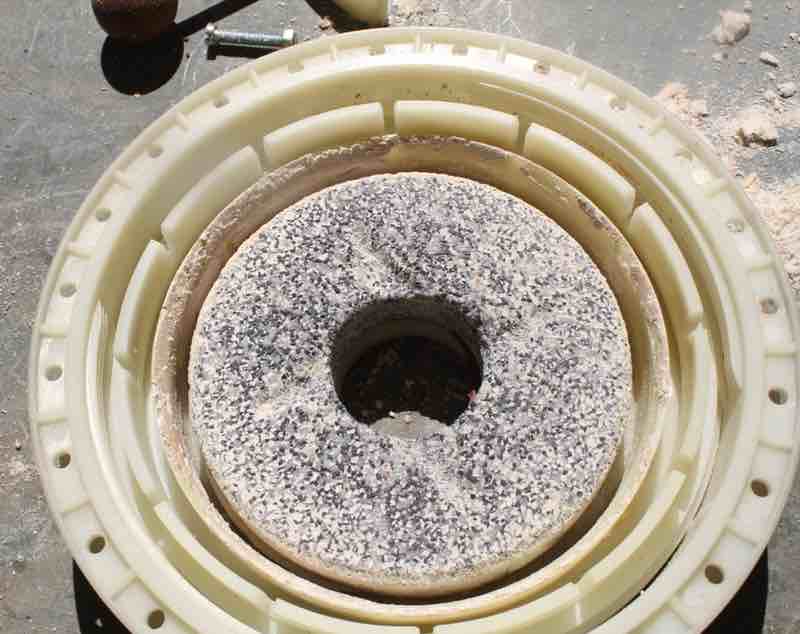
Our first grain mill, a Hawo, is still in daily use; it is 25-years old and whilst expensive has paid itself off many times over. It can only be used for grinding wheat. There are other options but stone mills like our Hawo remain king; they heat up more slowly, a significant problem in the grinding of flour. Thus I don't grind more than enough flour for two or perhaps three-loaves of bread at one time. Known as a stone-burr mill, the wheat is ground between two roughened circular chunks of quartz about three inches in diameter, one stationary and the other driven by a powerful electric motor. They don't wear out, but I once tried to grind about 3kg without stopping for cooling and they got very hot and clogged. I had to strip the mill, hence the photo above and rigorously clean the stones with a wire brush. Now I grind no more than a couple of pounds at one time unless using frozen wheat. This is in fact is how wheat has been ground for centuries, driven either by a windmill or a water-wheel, but with much larger stones obviously.
For this reason we have recently bought a KoMo which I will be shortly using to mill mealies (corn) for whole 100% wholegrain porridge, called pap in South Africa, and putu, a dry crumbly breakfast cereal loved by the Zulu people. Made with commercial refined mealie-meal they are tasteless and without all these nutrients.
Avoid hand-cranked mills is my advice; I have had one but they simply do not grind the flour fine enough. Likewise attachments for blenders have limitations. Spend the extra and get a proper dedicated grain-mill. Metal-burr mills grind the wheat rather like a pepper-grinder; between two roughened steel plates. They produce a finer grade of flour but generate a lot of heat; the flour itself gets hot. Impact-mills grind the grain between two steel heads that spin in opposite directions. I have no experience of them but they are apparently very noisy. A very popular stone-burr mill is the Mockmill. It is solid German technology and looks not unlike our Hawo, but using a composite rock. It comes in two sizes, the 100 and the 200. All grinders are noisy but the stone-burr mills are a little less so. One should probably don ear defenders.
The markup from wheat to the best commercial flour, in South Africa at any rate, is about four times. That means that every loaf of bread that I bake has a saving of R9 and the Hawo flour is far better, fresh and with 100% of the nutrients in wheat. Since I bake daily, at one loaf per day, that comes to a saving of R3285 per annum; more really as I often make for friends and family too.
A few tipsGenerally one wants to grind flour as fine as possible, so move the setting so that the stones are close together without actually touching; you will hear a quite different sound, then back off quickly or you may get grit in your flour.When starting the mill it is better to first slacken off the setting of the stones or they may jam and possibly damage the motor. Switch off immediately if that happens. Then adjust the setting again with the mill in action until the stones are almost but not quite touching. You will soon figure it out. If grinding more flour than for one loaf, then place your hands on the outside of the container; you will soon feel if it is getting too hot. Heat will drive off those molecules that give your home-ground flour its special flavour and may affect the nature of the gluten, changing the way in which it rises and potentially ruining your loaf. I use frozen wheat when milling more than a kilogramme. It's all about experimentation and one soon learns that baking like brewing is a complex business. The challenge either excites and intrigues you and gets you interested, or puts you off and you return to commercial bread. This is not a journey to be started lightly. I admit it candidly that I do this not because our bread tastes so much better than the commercial loaf; the real reason is the huge step-up to greater wellbeing.
Anti-nutrientsAnti-nutrients are substances like lectins and phytates that are found in many wholesome foods. Avoiding them is impossible for those who love a wide range of nuts, vegetables and seeds; and grains too for example. But there are ways of mitigating their effects.Anti-nutrients inhibit the absorption of many minerals; that is beyond debate. However those enjoying a wide range of wholesome foods have nothing to fear; otherwise every vegetarian would be anaemic and suffer from osteoporosis. The anti-nutrient lobby would have you absolutely avoid 100% wholemeal flour which certainly does have phytates; in fact there is also research saying they are important for us too. It's a complex subject, and I recommend you do your own reading and make up your own mind. GlutenGluten is the protein in bread; without it bread will never rise and gain the texture we are familiar with. A very small percentage of people react badly to it and suffer from a serious disease called Coeliac Sprue. Generally they must simply avoid all such grains.However commercial bread causes many people distress because of the enzymes added, but the gluten gets the blame. There is great concern in nutritional circles because those who get the colly-wobbles from commercial bread then, thinking it is the gluten, often change from whole to highly refined grains. NixtamalNixtamal is something I know nothing about; it is a new inviting avenue of make masa, the dough made for at least three thousand years by the people of Central America. Proponents of this method claim it makes the corn more digestible and with greater nutritional benefits.Unlocking Nixtamal meaning-of-gluten.html Evil"Evil is unspectacular and always human, and shares our bed and eats at our own table," said the profound thinker W.H. Auden. And it is always based on a lie, an untruth, call it what you will.Few things have undermined the wellness of mankind compared with the big fat lie that wholewheat-bread is made with wholemeal flour. When we see the term 'wholemeal' we believe this must be good for us, but it is utterly untrue. Millers by international agreement are allowed to call their product 'wholemeal' provided they do not remove more than 40% of the goodies. All the best parts have been milled out and sold to the pig farmer and pharmaceutical companies that process it further and sell us minerals and vitamins in supplements. Eating at your table, in the words of Auden is a monstrous evil called wholewheat bread. Nearly a half of the vitamins, protein and bran have been stripped out of it; phytochemicals and minerals too, and we are none the wiser. We are
the dupes.
"Evil always wins through the strength of its splendid dupes." — G. K. CHESTERTON Biblical accountBread is as part of our culture as biltong and mielie-pap. It is a fundamental part of our history going back millennia.On leaving Egypt at the beginning of their epic journey to what we today call the holy-land, the Israelites were sure not to leave their sourdough starter and their kneading bowls behind.
"So the people took their dough before it was leavened, and their kneading bowls..." - Exodus 12 Ketogenic dietsOne of the fundamental reasons why diets in general and more particularly those that demand that we give up all starches don't work, is that bread is so deeply ingrained in our very beings.Where I do agree with the ketogenic diets is that really we ought to for ever give up on commercial bread; it is fattening and very detrimental to our wellbeing. But if you mill your own flour, you can have your bread and eat it, so to speak. This is even more so if you use the ancient methods for leavening; a sourdough starter. We cheat a little by adding some yeast to make it lighter, with no detrimental effect that I know of.
Kefir sourdough bread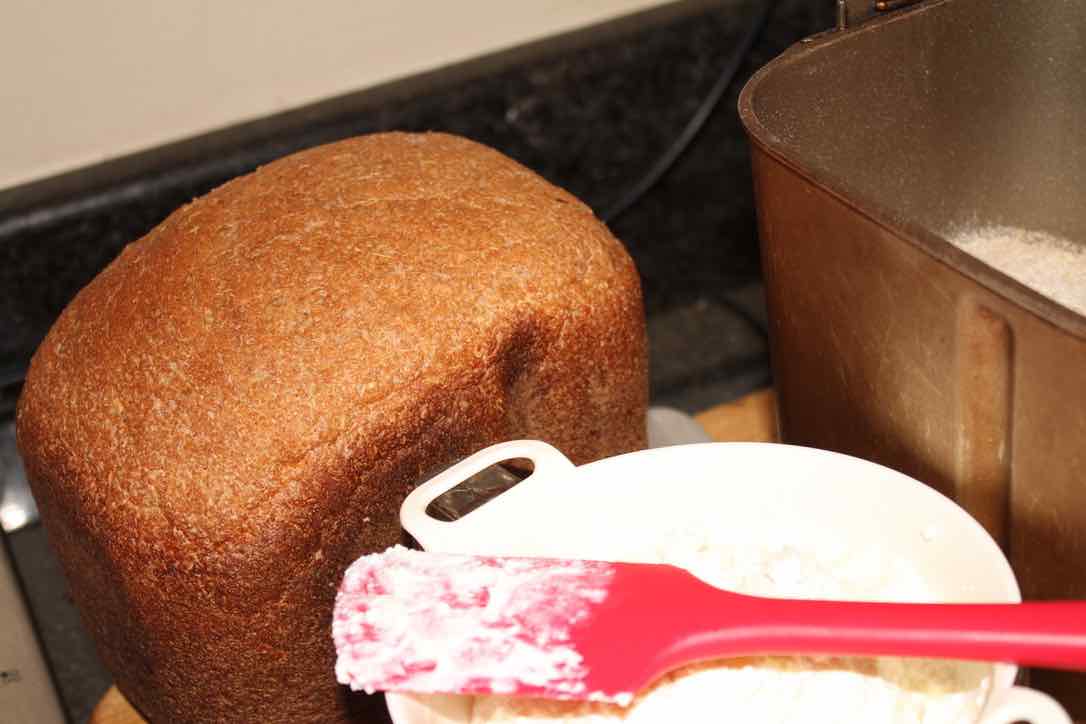
We have recently started using kefir as part of the leavening agent in our sourdough bread and been very pleasantly surprised that it makes for a much softer crumb. Kefir-sourdough-bread.html DiabetesWhole grains and diabetes are directly connected. The fibre, protein and fat that are extracted from wheat are the very factors that lower the glycemic index of carbs; that's why whole grains do not make us fat as white rice, commercial bread and mealie-meal do.There is an abundance of research confirming that whole grains are linked to greater well-being. Only they are very difficult to get. Mill your own flour if you love bread as much as I do; there is no other way. There are around 500 million diabetics now world-wide, and the prevalence is set to rise by fifty percent in the next 25 years. Obesity and raised blood-glucose are ranked as the second and third leading risk factors for early death and disability. Unable to conceive giving up bread for ever, I turned to milling my own flour and baking sourdough; it's been life-changing. And we have the best-tasting and most nutritious bread in the world to show for our efforts.
To sum upI am certainly not so naive as to think that everyone reading this newsletter will rush out and start milling their own flour. But I do ask that you don't dismiss the idea out of hand as totally absurd.A better alternative perhaps is to get together with other like-minded folk who are serious about their wellbeing. One person buys a mill, finds a wheat farmer and the rest purchase freshly milled 100% flour from him or her. I've said it before and it's worth repeating; this is how they do it in the Blue Zones of the world where ten-times as many people live to vigorous old age. This is the way of life that I give wholly the credit for the fact that well into our seventies now, neither of us take any medication whatsoever.
Next monthNext month we will look at the benefits of milling your own corn, or maize as we call it in South Africa.
Till next month, Bernie
Create a cyan zone at your homeClick here to return to the home page and subscribe to this newsletter, if you have not already. Care for the world, look after your family.It is simple to deregister if you later find it boring or irrelevant. Don't spam, but please forward to a few selected friends who you think might be interested in sitting under the trees they once planted, sipping tea and watching the great-grandchildren growing up; and still able to take long walks.
x Alternative types of water storage x Wear your clothes out x Comfort foods x Create a bee-friendly environment x Go to bed slightly hungry x Keep bees x Blue zone folk are religious x Reduce plastic waste x Family is important x What can go in compost? x Grow broad beans for longevity x Harvest and store sunshine x Blue zone exercise x Harvest and store your rainwater x Create a cyan zone at your home |
| Back to Back Issues Page |
